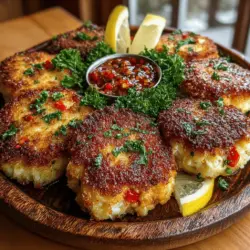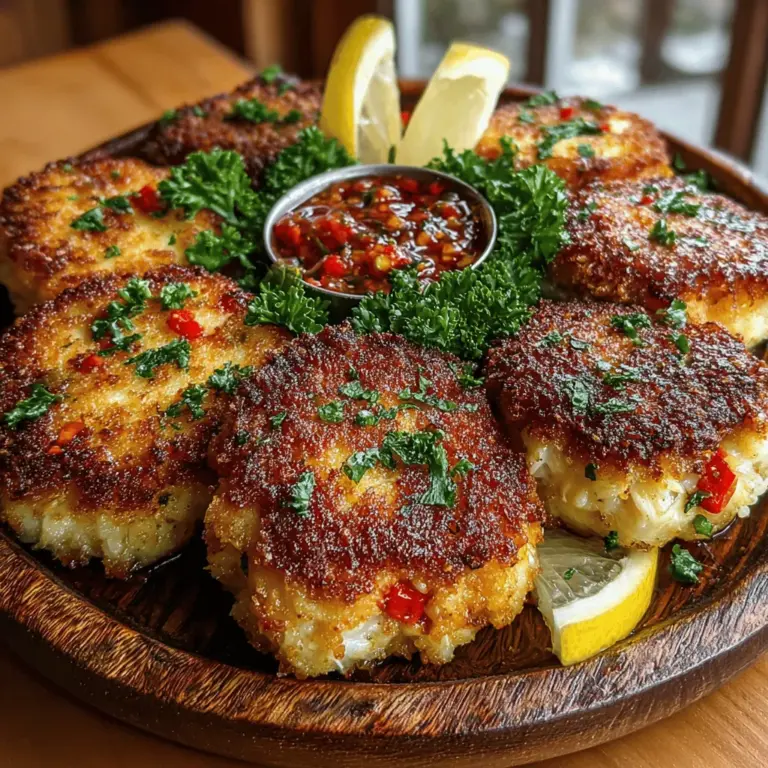Golden Crispy Crab Cakes: A Delectable Seafood Delight
Crab cakes have long been a favored seafood dish, celebrated for their rich flavors and delightful textures. Originating from coastal regions, particularly in the Chesapeake Bay area, these savory cakes have transcended their humble beginnings to become a staple in seafood cuisine across the globe. Their blend of sweet crab meat, aromatic seasonings, and crispy exteriors makes them not only a treat for the palate but also a versatile dish that can be served as appetizers, main courses, or even in sandwiches. Among the myriad of crab cake recipes available, Golden Crispy Crab Cakes stand out for their perfect balance of crunch and tenderness, making them an irresistible choice for seafood lovers.
The appeal of Golden Crispy Crab Cakes lies not only in their delicious flavor but also in their stunning presentation. When cooked to perfection, they boast a golden-brown exterior that gives way to a moist and flavorful interior, showcasing the star ingredient: fresh crab meat. The key to achieving that coveted texture and taste is in the quality of the ingredients used. Fresh crab meat, sourced from local markets or caught the same day, is essential for delivering the authentic seafood flavor that crab cakes are known for. This commitment to using fresh, high-quality ingredients elevates the dish, ensuring that every bite is a celebration of the ocean’s bounty.
Understanding the Ingredients
To create these Golden Crispy Crab Cakes, it’s vital to understand the role each ingredient plays in crafting the perfect dish. The foundation starts with fresh lump crab meat, which is the primary ingredient. When selecting crab meat, always choose high-quality, fresh options. The sweetness and delicate flavor of lump crab meat are unmatched, and using imitation crab or canned varieties can significantly compromise the integrity of your crab cakes.
Next, we incorporate finely diced red bell pepper and green onion. These vegetables not only provide color but also add a subtle crunch and sweetness that complements the crab. The red bell pepper’s vibrancy enhances the visual appeal of the crab cakes, while the green onion contributes a mild onion flavor that brightens the overall taste profile.
For binding and moisture, mayonnaise and egg are indispensable. Mayonnaise adds creaminess and richness, while the egg acts as a binder, helping the crab cakes hold together during cooking. Together, they ensure that the cakes remain moist on the inside while achieving that desired crispy exterior.
To enhance the flavor further, we use Dijon mustard and Worcestershire sauce. These ingredients impart a tangy depth that elevates the crab cakes beyond simple seafood fare. The Dijon mustard offers a subtle bite, while Worcestershire sauce introduces umami notes that round out the flavor profile.
Old Bay seasoning, a classic in seafood dishes, is a must-have for any crab cake recipe. This blend of spices, including celery salt, black pepper, and paprika, adds a distinctive flavor that is synonymous with crab cakes, particularly in the Mid-Atlantic region. It’s not just about seasoning; it’s about tradition and the authentic taste that Old Bay brings to the dish.
Breadcrumbs are crucial for achieving the signature crispy crust that defines Golden Crispy Crab Cakes. Whether you opt for panko or traditional breadcrumbs, they provide the necessary crunch that contrasts beautifully with the tender crab meat inside.
Lastly, a sprinkle of fresh parsley not only adds a pop of color but also a fresh herbaceous note that brightens the dish, making it visually appealing and enhancing the overall flavor.
Step-by-Step Guide to Making Golden Crispy Crab Cakes
Preparing the Mixture
The first step in crafting the perfect Golden Crispy Crab Cakes is preparing the mixture. Begin by gently combining your fresh lump crab meat with the diced red bell pepper, green onion, mayonnaise, egg, Dijon mustard, Worcestershire sauce, Old Bay seasoning, and parsley. It’s crucial to handle the crab meat delicately to preserve its integrity; overmixing can lead to a dense texture. Instead, fold the ingredients together gently using a spatula. This method ensures that the crab remains in larger pieces, allowing for that delightful bite of sweet crab in every cake.
Chilling the Mixture
Once your mixture is combined, the next step is chilling it. This step is often overlooked, but it is paramount for the success of your crab cakes. Cover the mixture with plastic wrap and refrigerate it for at least 30 minutes. Chilling helps the flavors meld together, but more importantly, it firms up the mixture, making it easier to shape into patties. This step is essential for maintaining the structure of the crab cakes, preventing them from falling apart during cooking.
Shaping the Crab Cakes
After the mixture has chilled, it’s time to form the crab cakes. Use a measuring cup or your hands to scoop out portions of the mixture. Aim for uniform patties that are about 1 to 1.5 inches thick. A consistent size ensures that the crab cakes cook evenly. Gently shape each portion into a patty, taking care not to compress the mixture too much. The goal is to maintain air pockets within the crab cake for a light and fluffy texture. Once shaped, place the patties on a tray lined with parchment paper. If you have leftover mixture, you can easily store it in the refrigerator for another batch.
Coating the Crab Cakes
The final touch before cooking is the breadcrumb coating. For that extra crunch, coat each crab cake with breadcrumbs. To do this, gently press each patty into the breadcrumbs, ensuring an even coating on all sides. This step not only enhances the crispiness of the crab cakes but also adds a beautiful golden color when cooked. For an added layer of flavor, consider using seasoned breadcrumbs or adding a sprinkle of Old Bay seasoning to the breadcrumb mixture.
With the crab cakes shaped and coated, you are now ready to move on to the cooking process, where the magic truly happens. Stay tuned as we delve into the frying techniques that will yield perfectly crispy, golden-brown crab cakes that are sure to impress.
Cooking the Crab Cakes
Once your crab cake mixture is prepared and resting, it’s time to bring those delightful patties to life! The cooking method is crucial in achieving that signature golden crispy exterior while keeping the inside moist and flavorful.
Ideal Frying Temperatures and Techniques
To achieve perfectly cooked crab cakes, it is essential to maintain the right frying temperature. Preheat your skillet or frying pan over medium-high heat until hot but not smoking. You can test whether the oil is ready by dropping a small amount of the crab cake mixture into the pan; if it sizzles immediately, you’re good to go.
1. Oil Selection: Choose a high-smoke-point oil such as canola, vegetable, or light olive oil. This ensures that the oil can withstand the frying temperature without burning.
2. Frying Method: Carefully place your crab cakes into the hot oil, ensuring they are not overcrowded. Crowding the pan can lower the oil temperature and result in soggy cakes. Fry in batches if necessary.
3. Cooking Time: Cook each crab cake for about 4-5 minutes on one side until it forms a beautiful golden crust. Gently flip each cake using a spatula, and cook for an additional 3-4 minutes on the other side. Keep an eye on them to prevent burning; adjusting the heat as necessary will help to maintain even cooking.
By following these frying techniques, you’ll end up with crab cakes that are crispy on the outside and tender on the inside.
Draining and Serving
After frying, it is important to drain the excess oil to maintain the crispiness of the crab cakes. Here’s how to do it effectively:
1. Draining Method: Once the crab cakes are golden brown and cooked through, use a slotted spatula to transfer them to a plate lined with paper towels. This will absorb any excess oil, keeping the cakes light and crispy.
2. Presentation: Serve your crab cakes on a large platter or individual plates. For a professional touch, you can garnish with fresh herbs, lemon wedges, or microgreens for a splash of color.
Flavor Profiles and Serving Suggestions
The flavor profile of Golden Crispy Crab Cakes is a harmonious blend of sweet, savory, and slightly tangy notes. The sweetness of the crab meat shines through, complemented by the freshness of herbs like parsley and the subtle kick from spices.
Recommended Serving Suggestions
– Dipping Sauces: A classic tartar sauce pairs wonderfully with crab cakes, bringing a creamy, tangy element that enhances the flavors. Alternatively, for those who enjoy a bit of heat, a spicy remoulade adds a bold, zesty kick that elevates the dish.
– Accompaniments: Serve your crab cakes alongside a refreshing coleslaw for a crunchy contrast or a vibrant salad featuring mixed greens, cherry tomatoes, and a light vinaigrette. These sides balance the richness of the crab cakes and add a nutritious element to your meal.
Nutritional Benefits of Crab Cakes
Crab cakes are not only delicious but also offer a variety of nutritional benefits from their key ingredients:
– Protein Content: Crab meat is an excellent source of high-quality protein, making it a great option for those looking to increase their protein intake without consuming excessive calories. Just one serving of crab cakes can provide a substantial amount of protein to support muscle health and keep you feeling full.
– Vitamins and Minerals: The vegetables used in the crab cake mixture, such as bell peppers and onions, contribute essential vitamins and minerals. For instance, bell peppers are rich in vitamin C, which is beneficial for immune health, while onions provide antioxidants that support overall wellness.
– Healthy Fats: Using olive oil for frying not only adds flavor but also provides healthy monounsaturated fats that can help reduce bad cholesterol levels. These fats are important for heart health and can contribute to a balanced diet.
Culinary Variations and Adaptations
While the classic crab cake recipe is undoubtedly delightful, there are plenty of culinary variations and adaptations you can explore to suit your taste or dietary preferences:
– Herbs and Spices: Experiment with different herbs like dill, cilantro, or even Cajun seasoning for a southern twist. Each herb will impart a unique flavor to the crab cakes, allowing you to personalize the dish.
– Gluten-Free Options: For those avoiding gluten, you can use alternative breadcrumbs made from ground rice or gluten-free panko. This ensures you can enjoy crispy crab cakes without the worry of gluten exposure.
– Vegetarian Adaptations: If you’re interested in a plant-based version, consider using canned chickpeas or a combination of vegetables and legumes to create a crab cake-like texture. Adding seaweed or nutritional yeast can mimic the oceanic flavor of crab, making it a satisfying alternative.
Conclusion
Crafting Golden Crispy Crab Cakes is a delightful culinary experience that brings the flavors of the sea right to your plate. The simplicity of the recipe, combined with fresh, high-quality ingredients, makes it an approachable dish for both novice and experienced cooks alike.
As you embark on this cooking adventure, don’t hesitate to experiment with the recipe. Whether you stick to the classic flavors or take a creative detour with variations, the joy of cooking and sharing homemade crab cakes is truly rewarding. We encourage you to try this recipe, savor each bite, and share your experience with friends and family. Happy cooking!


